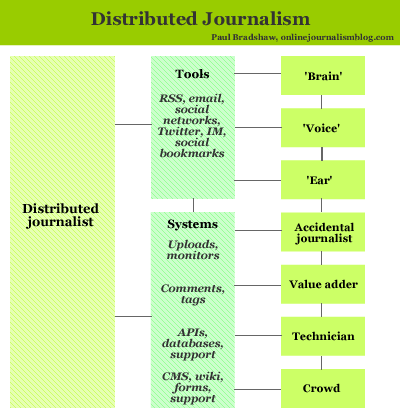Campbell, Vincent. Information Age Journalism: Journalism in an International Context. New York: Arnold PN4731,C38 2004.
Dimitrova, Daniela and Matt Neznanski. "Online Journalism and the War in Cyberspace: A Comparison Between U.S. and International Newspapers." Journal of Computer-Mediated Communication 12:1 (2006).
Three-State Model of Online News
Deuze, Mark. "Online Journalism: Modeling the First Generation of News Media on the World Wide Web." First Monday (Sept 2001).
Mainstream, Index and Category, Meta & Comment, Share and DiscussionGreen, David. "A General Model for On-line Publishing." Charles Sturt University, NSW Australia.
Gilder, George. Hybrid Model. In Chris Lapham, "The Evolution of the Newspaper of the Future," CMC Magazine, 1 July 1995.Abstract: "Here I describe a general model of on-line publishing that focuses on the sequence of major processes involved - from submission to delivery. It identifies submission, acquisition, quality control, production and delivery as the main steps involved. This model applies to virtually any material and provides a basis for automating many editorial and publishing functions via specialised high-level languages. The benefits include fast installation of new publications and cost-effective operation. Many applications of this approach have been implemented at Charles Sturt University."
Li Xi Gen. "Web page design affects news retrieval efficiency. "Newspaper Research Journal, Winter 2002. http://findarticles.com/p/articles/mi_qa3677/is_200201/ai_n9084346/pg_1?tag=artBody;col1
Meyer, Philip. The Vanishing Newspaper: Saving Journalism in the Information Age. Columbia MO: University of Missouri Press, PN4867.2.M49 2004.
Societal Influential Model for the Newspaper Industry
Nanopublishing - Online, low-cost publishing which utilizes blogs and techniques based on blogging in order to target a specific audience. Wiktionary.
Murdoch, Rupert. Three Tiers of Content. From "The Future of Newspapers: Moving Beyond Dead Trees." Boyer Lectures. 16 Nov 2008. http://www.abc.net.au/rn/boyerlectures/stories/2008/2397940.htm#transcript
- Free content
- Subscription
- Premium service: customers customize high-end financial news and analysis
Seib, Philip. going live: Getting the News Right in a Real-Time, Online World. Lanham MD: Rowman & Littlefield PN4784.T4.S44 2001
Smith, Richard. "Online Scholarly Publishing in Canada: Technology and Systems for the Humanities and Social Sciences." Canadian Journal of Communication 29:3 (2004).
Do It Yourself, Adopt and Adapt, Self-Service Hosted, Full Service Systems and Portals, Toolbox, International Collaboration, International Repositories and the LibrariesPodcasting





